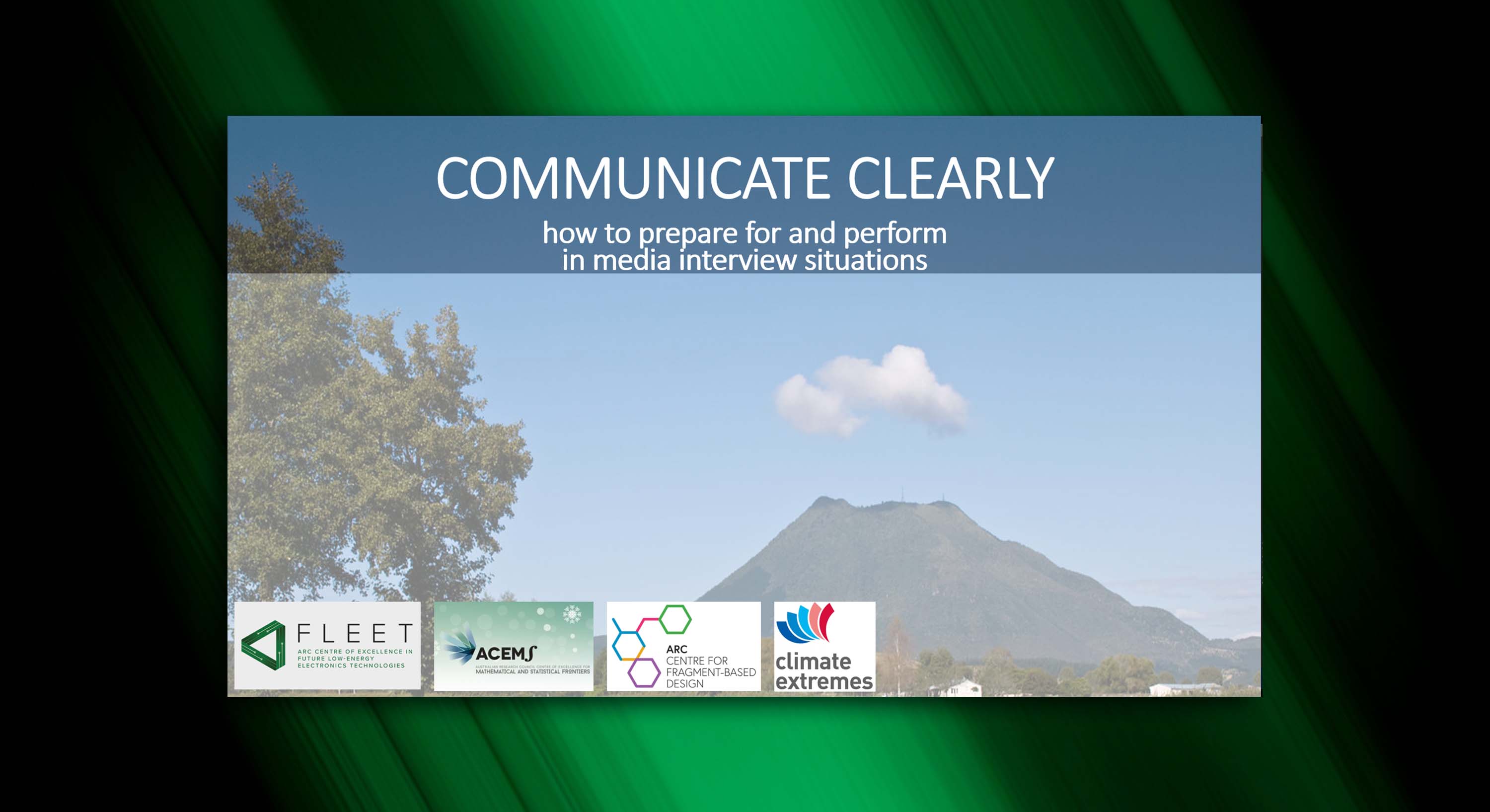Centre communications cover both internal and external needs. While the two audiences are very different, base content is used across both areas, to maximise efficiency.
FLEET’s communications functions include:
- Internal communication to maintain a cohesive Centre
- Informing the Australian public of the benefits being gained from research funded by the Australian Research Council (ARC)
- Supporting FLEET’s outreach functions to build a more science-aware public
- Appropriately communicating FLEET’s research outputs to different audiences, from the general public to the research community and potential collaborators, industry partners and end users
- Building the transferable communications skills of FLEET members.
Many 2020 Centre communication initiatives in response to Covid-related challenges to internal cohesion have remained valuable in 2021, and will likely become an ongoing part of Centre operations after the end of the pandemic. These include:
- Maintaining a higher number of internal Centre seminars (eight in 2021)
- Sending weekly email digests, including Zoom links, to members and affiliates to summarise Centre and relevant online events
- Extending the use of online virtual meetings to alternative platforms Kumospace and MeetAnyway to allow organic discussions and poster sessions, including at the Centre’s annual workshop
- Boosting the transpacific series of condensed-matter talks (14 talks in 2021) and running the Multiferroics conference to maintain links with international research communities (see case study)
- Continuing to seek out opportunities to partner with other science organisations in delivering ‘Covid safe’ science and training (see Professional Collaborations)
- Promoting FLEET researchers’ work via increased numbers of research blog posts and press releases (30 in 2021).
Communication highlights in 2021
- Producing Acknowledgement of Country guidelines
- Publishing 13 articles in Materials Australia magazine, reaching industry audiences
- Four FLEET ECRs meeting government and policymakers at STA’s annual Science Meets Parliament (see case study)
- Running media and presentations training for members, in collaboration with ARC Centres for Mathematical and Statistical Frontiers (ACEMS) and Fragment-Based Design (CFBD)
- Over 100,000 reached on external site Phys.org
- FLEET Director Prof Michael Fuhrer talking to Cosmos magazine about semiconductor manufacture and the end of Moore's Law.
- Jared Cole and Kris Helmerson's appearance in the National Science Quiz.
FLEET will:
- Promote public science awareness
- Improve public understanding of quantum science, electronics and sustainable computing
- Establish strong, lasting links between Australian and international science communities
- Develop the transferable (communication) skills of Australia’s next generation of science leaders
- Improve public perception of diversity in science
Internal communication
FLEET’s internal communications function to:
- Foster Centre cohesiveness, both between participating nodes and between different research areas
- Improve understanding (e.g. between two quite diverse research fields: quantum information theory and nanodevice fabrication)
- Encourage collaborations between nodes and across research areas
- Ensure members know they are supported by the Centre
- Disseminate important information to members in a timely fashion
- Support other Centre strategic priorities, for example, in development, outreach, and equity (e.g. see FLEET Acknowledgement of Country).
FLEET’s internal communications playbook is shared with members on the Centre intranet, along with annual reports, communications FAQ (process for getting studies published) and communications contacts at participating nodes.
In addition to the intranet, annual reports and the regular newsletter, all new members receive welcome emails outlining necessary Centre functions, logins and tools, and all-Centre meetings are used to keep members up to date with strategic goals, Centre processes and support mechanisms.
FLEET introduced a number of new communications initiatives in 2020 as Covid and the lockdown took hold, and each of these proved useful at different times.
FLEET member survey response
“I think FLEET has narrowed the gap between the operations team and researchers. There is a 'personal' touch with FLEET's internal communication – it almost feels like home/family.
FLEET member survey response

Being part of national research centre during a pandemic has been an interesting experience, as it pushed us to adopt new communication tools and new ways of connecting. Overall, I think 2021 saw a growing awareness of what worked and what didn’t work. Personally, I found the new norm of “long-distance relationships” opened up some interesting possibilities for collaboration. That being said, “Zoom-fatigue” was a growing issue that members identified, and I can empathise so I am very eagerly looking forward to our face-to-face and hybrid meetings in 2022.
Dr David Cortie FLEET Communications Chair
Communications self-sufficiency
While our members are in a Centre of Excellence, they have access to a communications coordinator who can help them share their research. But this will probably not be the case for most of a scientist’s career. Therefore individuals should develop sufficient skills in communicating their research that they can do this themselves, without a full‐time comms professional to help.
At FLEET, we are striving to develop the communications skills of our members, giving members the skills to share their research through several channels, including effectively leveraging university communications teams, online scientific platforms, and social media. An impressive 70% of FLEET members follow and engage with Centre social media accounts.
Progress towards this in 2021 includes:
- Building skills: sourcing and delivering communications training
- Supporting members in the recording of ‘explainer’ videos
- Finding opportunities and encouraging members to write non‐peer reviewed articles – 25 articles in 2021
- Encouraging and supporting members sharing their science on social media
- Supporting members presenting their research in a public forum (see Outreach)
- Encouraging and supporting ECR and student members participating in Three‐Minute Thesis, FameLab, Visualise Your Thesis, Science in the Pub, and similar.
Also see Honing members’ communications skills.

We encourage members to take advantage of having a dedicated comms person now, at FLEET, to learn all the skills, to become ‘self sufficient’ in publicising their science. This means that in the future, they will be prepared for not having access to a dedicated comms person.
Errol Hunt FLEET Senior Communications Coordinator
FLEET news
The Centre’s monthly newsletter reaches all 230 members and partners, with an edited version going to 220 external affiliates, followers and stakeholders. The newsletter achieves an open rate of approximately 50% among members, with 79% of members saying they find it useful.
As well as two or three highlight research stories each month, the newsletter shares wider FLEET news, including upcoming events, equity and training initiatives, Centre members’ achievements, promotions and awards, and alum spotlights (see FLEET alumni). A regular feature congratulates ECRs as first and second authors that month.

FLEET’s NZ partner organisation the MacDiarmid Institute reached out to FLEET Chief Investigator partner Prof Kourosh Kalantar-zadeh after reading about a 2020 study, leading to an NZ–Australia collaboration on surface‐patterns, published in Nature.
Frequent newsletters are nicely put together and update members with what's going on in FLEET and Centre's research achievements.
FLEET member survey response
FLEET Research blog
FLEET’s research blogs are the ‘meat’ in the communication sandwich, driving multiple communications channels (website, newsletter, social media, website, annual report), both external and internal.
FLEET’s blog forms an extremely effective channel:
- Promoting members’ research
- Celebrating members’ achievements
- Highlighting Centre engagement with partners and the wider community.
FLEET puts significant effort into web-based blog posts that share Centre research news, along with outreach, training, equity and other news. The research blog targets both internal and external audiences.
The fresh, regularly-updated content from FLEET’s research blog provides the content that keeps FLEET’s social media fresh, providing compelling content for 3200 followers on Twitter, Facebook and LinkedIn.
Short descriptions linking to blog posts in the Centre’s monthly newsletter also provide broad news to members, affiliates and stakeholders.
The same content, pushed out to online science platforms, supports the Centre’s online media mentions and drives researchers’ Altmetric rankings. FLEET papers given this coverage have consistently ranked in Altmetric’s top 5% of papers tracked.
Reach on external sites significantly exceeds views on FLEET’s own website. For example, on Phys.org alone, FLEET stories reached over 100,000 readers. Presence on these sites also means ongoing accessibility/publicity for the work done by our people long after the tenure of FLEET, even without the assistance of the planned FLEET legacy website archive.
After posting a good paper online and promoting via FLEET, a lot of news has come out about our paper. This not only helps the citation but also provides more opportunities for collaboration as others will be interested in our work.
FLEET member survey response
FLEET members are highly convinced of the value of this coverage, with surveying indicating that 85% of members are aware FLEET can publicise their research, and over 90% of research blogs now suggested by the researchers, rather than prompted by the coordinator.
Most articles are aimed at a ‘physics aware’ audience, with the first section of the article aimed at a ‘science aware’ but non‐physics audience. Thus, the maximum number of people will get some understanding from the start of the article, with more detail for increasingly‐expert readers later on. This allows articles to be published on as wide as possible a range of outlets.
For internal purposes, articles aim to improve understanding of other work around the Centre. The aim is, for example, that an Enabling technology B (nanofabrication) PhD student will be able to read and understand an article about Research theme 3 (non‐equilibrium physics), and vice versa. This internal sharing of research blogs is accomplished via newsletter and social media.
FLEET uses mainstream media, university and partner communication teams, and online science platforms to communicate Centre research results to the public as well as to science peers. The Centre has twice voluntarily increased the ‘media mentions’ target, after exceeding the original goal by a factor of more than 10, and in 2021 has once again exceeded this KPI.
In 2020–21, with many members concentrating on write-up, the Centre put extra effort into sharing the news of this research. In total, 30 FLEET stories had full press-release distribution (compared with 10–13 in pre-Covid years), with these driving the bulk of the Centre’s 459 media mentions in 2021, and improving members’ visibility to potential global collaborators and industry.
Also see FLEET's online and social-media news functions.
FLEET engages with the scientific research community through research stories published on key online science platforms and stakeholders’ newsletters.
FLEET COMMUNICATIONS STRATEGY


